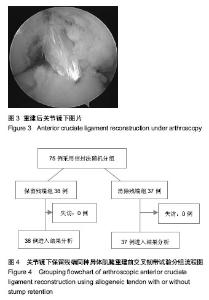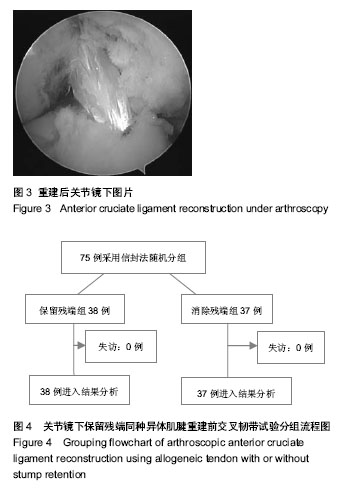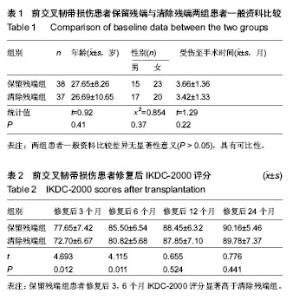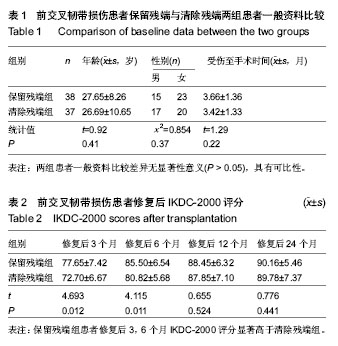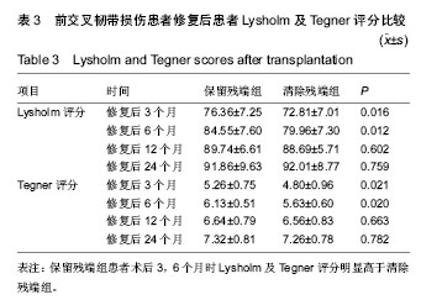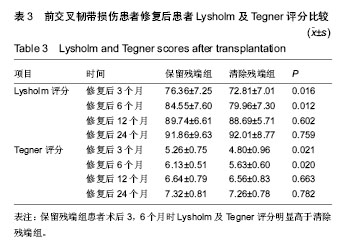| [1] Huston LJ,Greenfield ML,Wojtys EM. Anterior cruciate ligament injuries in female athlete.Clin Orthop Relat Res. 2010;(372):50-63.
[2] 吴波,杨柳.前交叉韧带解剖和生物力学特性[J].中国矫形外科杂志,2006,22(14):1725-1726.
[3] 王秀峰,杨光,徐铁峰,等.前交叉韧带单束重建和双束解剖重建短期临床疗效的病例对照研究[J].中国骨伤,2012,28(11):891-894.
[4] Junkin DM Jr,Johnson DL.ACL tibial remnant,to save or not Orthopedics, 2010;31(2):154-159
[5] Lee BI,Kwon SW,Kim JB,et al.Comparison of clinical results according to amount of preserved remnant in arthroscopic anterior cruciate ligament reconstruction using quadrupled hamstring graf. Arthroscopy.2008;24:560-568.
[6] Bogunovic L, Matava MJ.Operative and nonoperative treatment options for ACL tears in the adult patient:a conceptual review.Phys Sportsmed.2013;41(4):33-40.
[7] 成世高,王万春.自体腘绳肌双束与单束重建膝关节前交叉韧带[J].中国组织工程研究与临床康复,2011,15(7):1313-1316.
[8] 王秀峰,杨光,徐铁峰,等.前交叉韧带单束重建和双束解剖重建短期临床疗效的病例对照研究[J].中国骨伤,2012,28(11):891-894.
[9] 王洪,孟春庆,段德宇,等.关节镜下自体腘绳肌和异体胫前肌单束重建前交叉韧带的1年随访比较[J].中国组织工程研究与临床康复,2011,15(53):10064-10067.
[10] Shen W,Forsythe B,Ingham SM,et al.Application of the anatomic double-bundle reconstruction concept to revision and augmentation anterior cruciate ligament surgeries.J Bone Joint Surg Am.2008;90 Suppl 4:20-34.
[11] 张辉,冯华,洪雷,等.导航辅助前十字韧带单束与双束重建的比较研究[J].中华骨科杂志,2012,32(6):557-564.
[12] Alentorn-Geli E, Myer GD, Silvers HJ, et al. Prevention of non-contact anterior cruciate ligament injuries in soccer players. Part 1: Mechanisms of injury and underlying risk factors. Knee Surg Sports Traumatol Arthrosc. 2009; 17(7): 705-729.
[13] Xie GM, Huang Fu XQ, Zhao JZ. The effect of remnant preservation on patterns of gene expression in a rabbit model of anterior cruciate ligament reconstruction. J Surg Res.2012; 176(2):510-516.
[14] Li Z, Liu Y, Shi B, et al.An experimental study on anterior cruciate ligament reconstruction with remnants and remaining bundle preservation. Zhongguo Xiu Fu Chong Jian Wai Ke Za Zhi. 2009 Mar;23(3):282-286.
[15] Kondo E,Yasuda K,Azuma H,et al.Prospective clinical comparisons of anatomic double-bundle versus singlebundle anterior cruciate ligament reconstruction procedures in 328 consecutive patients.Am J Sports Med.2008;36(9): 1675-1687.
[16] 陈明,董启榕,徐炜,等.单束与双束解剖重建前交叉韧带临床疗效的荟萃分析.中华外科杂志,2010,48(17):1332-1336.
[17] 王飞,陈百成,康慧君,等.关节镜下髌韧带和六股异体腘绳肌腱单束重建前交叉韧带的临床研究.中华外科杂志,2011,49(7): 592-596.
[18] Muneta T, Koga H, Ju YJ, et al. Remnant volume of anterior cruciate ligament correlates preoperative patients´ status and postoperative outcome. Knee Surg Sports Traumatol Arthrosc. Knee Surg Sports Traumatol Arthrosc. 2013;21(4):906-913.
[19] Neuman P,Kostogiannis I, Friden T, et al. Patellofemoral osteoasthritis 1 5 years after anterior cruciate ligament injury-a prospective cohort study.Osteoasthritis Cartilage. 2009;17(3):284-290.
[20] Jung YB, Jung HJ, Siti HT, et al.Comparison of anterior cruciate ligament reconstruction with preservation only versus remnant tensioning technique. Arthroscopy. 2011;27(9):1252-1258.
[21] Hensler D,Van Eck CF,Fu FH,et al.Anatomic anterior cruciate ligament reconstruction utilizing the double-bundle technique. J Orthop Sports Phys Ther. 2012; 42(3):184-195.
[22] Ahn JH,Lee YS,Ha HC.Anterior cruciate ligament reconstruction with preservation of remnant bundle using hamstring autograft: technical note. Arch Orthop Trauma Surg.2009; 129(8): 1011-1015.
[23] Crain EH,Fithian DC,Paxton EW,et al.Variation in anterior cruciate ligament sea pattern:does the seal pattern affect anterior laxity in anterior cruciate ligament-de fi cient knees? Arthroscopy.2005;21(1):19-24.
[24] Adaehi N, Ochi M, Uchio Y et al. Anterior cruciate ligament augmentation under asthroscopy. A minimum 2-year follow-up in 40 patients. Arch Orthop Trauma Surg.2000;120(3-4):128.133.
[25] Ham K,Moehizuki T,Sekiya I,et al.Anatomy ofnormal human anterior cruciate ligament attachments evaluated by divided small bundles.Am J Sports Med.2009;37(12):2386-2391.
[26] 罗浩,张卫光,敖英芳,等.膝关节前交叉韧带后外束股骨止点位置的解剖[J].解剖学报,2012,43(2):232-235.
[27] Kaeding CC,Aros B,Pedroza A,et al.Allograft Versus Autograft Anterior Cruciate Ligament Reconstruction:Predictors of Failure From a MOON Prospective Longitudinal Cohort. Orthopaedic Surgery. 2011:3(1):73-81.
[28] Cha J,Choi SH,Kwon JW,et al.Analysis of cyclops lesions after different anterior cruciate ligament reconstructions: a comparison of the single-bundle and remnant bundle preservation techniques. Skeletal Radiol.2012; 41(8):997-1002.
[29] Ochi M,Adachi N,Deie M, et al. Anterior cruciate ligament augmentation procedure with a1incision technique: anteromedial bundle or posterolateral bundlereconstruction. Arthroscopy.2006;22(4):463.el-5.
[30] 李志超,刘玉杰,石斌.保留残端纤维与剩余束重建前交叉韧带的实验研究[J].中国修复重建外科杂志,2009,23(3):282-286.
[31] Lee BI, Kwon SW, Kim JB, et al. Comparison of clinical results according to amount of preserved remnant in arthroscopic anterior cruciate ligament reconstruction using quadrupled hamstring graft. Arthroscopy.2013;24(5):560-568.
[32] 陈连旭,余家阔,敖英芳,等.前交叉韧带止点形态学测量及重建骨道直径探讨[J].中国运动医学杂志,2011,30(5):432-436.
[33] 杨光,何飞,李彦林,等.自体胭绳肌腱与同种异体肌腱移植重建前交叉韧带的临床疗效分析[J]. 昆明医学院学报.2011:(10): 54-57.
[34] Xie GM, Huang Fu XQ, et al. The effect of remnant preservation on patterns of gene expression in a rabbit model of anterior cruciate ligament reconstruction. J Surg Res. 2012; 176(2):510-516.
[35] Peterson RK, Shelton WR, Bomboy AL. Allograft versus autograft patellar tendon anterior cruciate ligament reconstruction: A 5-year follow-up. Arthroscopy. 2011;17(1): 9-13. |
